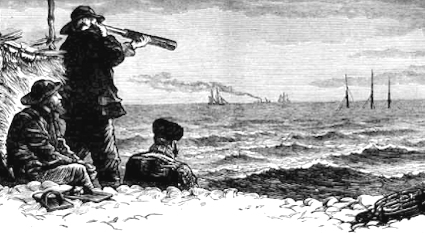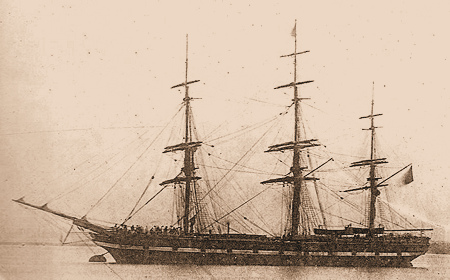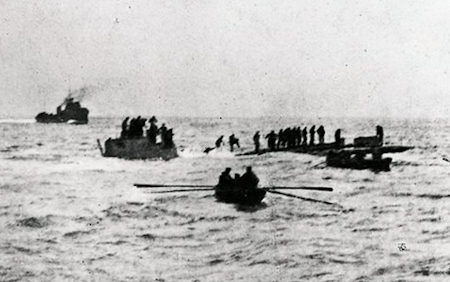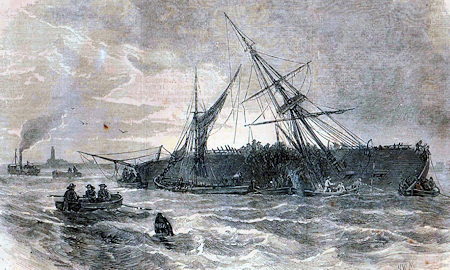Shipwrecks off Romney Marsh
NB You can see a comprehensive list of all Shipwrecks off the coast of Kent on the ![]() Wikipedia website.
Wikipedia website.


The City of London pub in Dymchurch was built in the sixteenth century as a coaching inn being mentioned in the Dr Syn stories as the Seawall Tavern.
There is a story of how the Seawall Tavern became the City of London. During a great storm in 1775, a ship called the City of London was shipwrecked off the coast of Dymchurch, with a great loss of life. So great was the storm and so gigantic the waves, that the ship was tossed up over the sea wall and crashed into the tavern, causing great damage to the building.
The tavern was restored using timbers from the colossal wreck and,as a commemoration for all the people who were killed, the tavern changed its name to the City of London. The figurehead of that ship now stands in the New Hall.
The signboard hanging outside the inn depicts the arms of the City of London, which incorporate Wat Tyler’s dagger. Wat Tyler was a man of Kent who in 1381 during the reign of Richard II, led an armed revolt against a tax levied on the populous, a poll tax. They marched on Canterbury and took Rochester Castle, then continued to march on to London. In a meeting between the rebels and the Lord Mayor of London, the goodly Mayor stabbed Wat Tyler to death.

HMS Blackwater was a Laird-type River-class destroyer ordered by the Royal Navy under the 1902–1903 Naval Estimates. Named after the River Blackwater in Essex, she was the first ship to carry this name in the Royal Navy.
On 6 April 1909 HMS Blackwater collided with the merchantman SS Hero, and sank off Dungeness in the English Channel at position 50°55′21″N 1°6′10″ECoordinates: 50°55′21″N 1°6′10″E.

HMS Ghurka was a Tribal-class destroyer built in 1907 for the Royal Navy. She served as part of the Dover Patrol during the First World War, playing a part in the sinking of the German submarine U-8 in 1915.
HMS Ghurka was sunk on 8 February 1917 off Dungeness after hitting a German mine. Only five of the crew survived, with 74 killed.
The wreck is located at a depth of 30 metres at 50°51′20″N 0°53′17″ECoordinates: 50°51′20″N 0°53′17″E. It is designated as a "protected place" under the Protection of Military Remains Act 1986.

The Northfleet was a British full-rigged ship of 951 tons gross built at Northfleet, Kent in 1853 and spent much of her career trading between England and Australia and between England, India and China.
In 1873 the Northfleet was on route from Gravesend in Kent to Tasmania with a cargo of equipment to build a railway and 379 persons on board: the pilot, 34 crew, three cabin passengers and the assisted emigrants comprising 248 men, 42 women and 52 children.
Bad weather forced the ship to drop anchor at several points before leaving the Channel and on the night of 22 January, she was at anchor about two or three miles (5 km) off Dungeness. Around 10.30 p.m. she was run down by a steamer that backed off and disappeared into the darkness.

The Northfleet
The heavily-laden Northfleet sank within half an hour, before vessels in the vicinity realised anything was amiss, and in the ensuing panic a total of 293 people were drowned. 86 were saved.
Of the women onboard only the captain's wife and one emigrant survived, along with just two of the children. Only two boats managed to get clear of the sinking ship, one without any oars and the other damaged. The captain, Captain Knowles, went down with his ship.
The offending steamer proved to be the Spanish steamship Murillo, which was stopped off Dover on 22 September 1873, eight months after the collision. A Court of Admiralty condemned her to be sold and severely censured her officers.
The window in the south wall of the chapel of St Nicholas Church in New Romney commemorates the crew and passengers who died. Angel trumpeters are shown calling them up to heaven out of the waves.

The Northfleet Disaster 1873

SM U-8 was one of the 329 submarines serving in the Imperial German Navy in World War I. U-8 was engaged in naval warfare and took part in the First Battle of the Atlantic.
Trapped in nets, forced to surface and scuttled under gunfire from HMS Gurkha and Maori, in the English Channel in March 1925, at position 50°56′N 01°16′E.
It is now a Protected Wreck Site off the local coastline, being scuttled during capture by the Dover Patrol. SM U-8 was designated following survey in 2016.

SM U-8 sinking after being scuttled on March 4, 1915

SM UC-50 was a German Type UC II minelaying submarine or U-boat in the German Imperial Navy during World War I. The U-boat was ordered on 20 November 1915 and was launched on 23 November 1916. She was commissioned into the German Imperial Navy on 21 December 1916 as SM UC-50.
In nine patrols UC-50 was credited with sinking 29 ships, either by torpedo or by mines laid. UC-50 was sunk by depth charges from British destroyer Zubian off Dungeness on 4 February 1918.

News Item at the time of The Wreck of the Spindrift 1869 off Dungeness:
The loss of the Spindrift, represented in the above picture, is remarkable from the circumstance that the vessel was wrecked within twenty-four hours after leaving the East India Docks, upon a well-known sand bank on the English coast.
There were only two passengers on board, and no lives were lost; but the Spindrift was a famous clipper in the China tea trade, and had on board when she left the Thames on the 21st ult., a general cargo valued at 200,000l,. Whether the wreck was the result of mismanagement and neglect of those in charge, a Trinity House pilot, or whether the catastrophe was unavoidable, is a question which is now the subject of judicial inquiry, under the direction of the Board of Trade.
It would be improper, therefore, to offer any opinion on the points here; but, waiting for the decision of the Court of Inquiry, it may be observed that the word “ unaccountable,” so frequently used in such cases, often covers the term “culpable.” To the inexperienced landsman, it is, at least, surprising that so fine a vessel, with a cargo so valuable, should be run on so dangerous and well-known a shoal as Dungeness Point.

The Spindrift wrecked off Dungeness 21 November 1869
The Spindrift was the property of Mr. James Findlay, of Greenock, and the cargo had been consigned by Messrs. Robertson and Co. of London, to Messrs. Adamson and Son of Shanghai. A considerable part of the cargo has been recovered


















